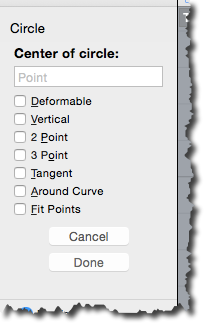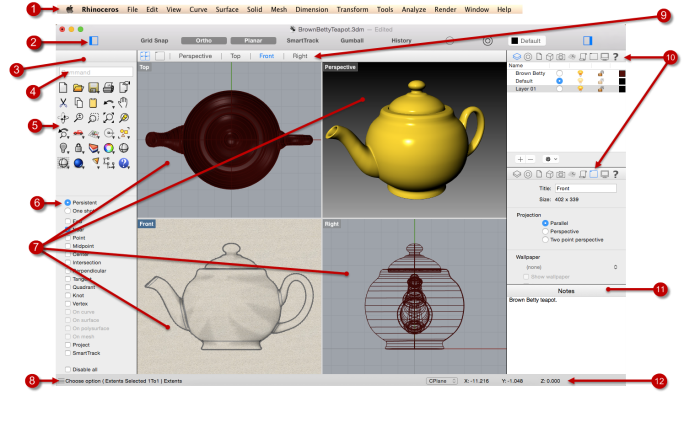下面這張圖片是 Rhino 視窗的主要界面功能。
 Menu
Menu
功能表以功能將 Rhino 的指令歸類。
 Application toolbar
Application toolbar
The application toolbar contains controls for various parts of the interface.
 左側邊欄
左側邊欄
Shows or hides the left sidebar.
鎖定格點
開啟格點鎖定。
Ortho
Turns on ortho mode.
Planar
Turns on planar mode.
SmartTrack
Enable SmartTrack object snaps.
Gumball
Enable the gumball object manipulator.
History
Start recording command history.
 顯示物件鎖點
顯示物件鎖點
Displays the object snap popover.
 顯示物件內容
顯示物件內容
Displays the Properties popover.
目前的圖層
Click the Layer pane to access quick controls for setting the selected object's layer or to change layer visibility and status.
 右側邊欄
右側邊欄
Shows or hides the right sidebar.
 左側邊欄
左側邊欄
The Left sidebar contains the command box, command toolbars and the object snap list.
 Command box
Command box
The command box displays a typed command. Once the command is accepted, the prompts, options and a value box appear in this space.

Command options
Command options change how a command acts. For example, when you draw a circle, the circle is normally drawn on the active construction plane. The Circle command has several options including Vertical and AroundCurve.
To use a command option, click the option name, or type the underlined letter of the option or the whole option name.
選擇指令選項
| 1. | Type Circle As soon as you have typed enough letters to uniquely identify the command, the Circle command automatically completes at the prompt. Press the Enter key or click the command name in the list. |
| 2. | The options for the Circle command appear: Center of circle:
|
| 3. | 要建立與使用中工作平面垂直的圓可以使用垂直選項。 Click Vertical, or type V. |
重複執行上一個指令
Many tasks in Rhino are repetitive. You might want to move or copy several objects, for example. Methods for repeating commands are provided.
重複執行上一個指令
| 4 | 沒有指令正在執行時按 Enter。 |
| 4 | In addition to pressing the Enter key on your keyboard, you can press the Spacebar or click the right mouse button in a viewport. These all perform the same function. |
Note:
Some commands, such as Undo and Delete do not repeat. Instead, the command prior to these commands is repeated. This prevents you from accidentally undoing too many commands or deleting objects accidentally.
In addition, you often want to repeat the command you were using before undoing a mistake. You can define the list of commands that do not repeat to suit your own way of working.
 Commands tool palette
Commands tool palette
Commands tool palettes contain graphical icons for initiating commands. Many icons have a second command that you can access by right-clicking or pressing the while clicking Option while clicking the icon. The tooltip that appears when you hover over the icon tells you what the left and right mouse button do.
Note:If you are using a one-button mouse or a track pad, to access the second command, hold the Option key and click.
 執行按鈕的第一個指令
執行按鈕的第一個指令
| 4 | Click the icon with the left mouse button. |
 執行按鈕的第二個指令
執行按鈕的第二個指令
| 4 | Click the button with the right mouse button. Or hold the Alt key and click. |
 物件鎖點
物件鎖點
包含持續性物件鎖點核取方塊。更多說明...
 作業視窗
作業視窗
Viewports display the Rhino working environment including object display, viewport title, background, construction plane grid, world axis icon. More...
Viewport context menu
| 4 | Right-click in a viewport to display a short-list of commonly used commands. |
When no object is selected
When objects are selected
 History panel
History panel
History panel contains the command history. One line with the last command appears on the status bar.

| 4 | Click the command history icon in the lower left corner of the screen to open a temporary window. |
Note: You can keep a history window open in the right sidebar.
 Viewport control bar
Viewport control bar
The Viewport control bar contains options for setting the viewport layout.
 Four viewports
Four viewports
Sets up a four-viewport layout with a top, right, front, and perspective view.
 One viewport
One viewport
Sets up a single-viewport layout by maximizing the current viewport.
Perspective | Top | Front | Right
Click to make a viewport current. This is especially useful in a one-viewport layout.
 右側邊欄
右側邊欄
The Right sidebar contains the panels for layers, properties, and other settings.
The icons determine which panel appears in the sidebar inspector.
Right-click the inspector toolbar to select which icons to display.
![]() When only one item is left, its name appears in the toolbar instead of the icon list.
When only one item is left, its name appears in the toolbar instead of the icon list.
 圖層
圖層
Displays the Layers panel.
 Objects
Objects
Displays the Properties panel.
 Notes
Notes
Displays the Notes panel.
 圖塊
圖塊
Displays the Block Manager panel.
 Views
Views
Displays the Named Views panel.
 工作平面
工作平面
Displays the Named CPlanes panel.
 History
History
Displays the Command History panel.
 作業視窗
作業視窗
Displays the Viewport Properties panel.
 顯示
顯示
Displays the Display Properties panel.
 Help
Help
Displays the Command Help panel.
 狀態列
狀態列
The status bar panes display the coordinates of the cursor in construction plane or world coordinates.
工作平面 / 世界
切換工作平面座標與世界座標。

x
滑鼠標記所在位置的 X 座標。
y
滑鼠標記所在位置的 Y 座標。
z
滑鼠標記所在位置的 Z 座標。
ToggleLeftSidebar
The ToggleLeftSidebar command shows or hides the left sidebar of the main modeling window.
This is the same as clicking on the leftmost icon in the toolbar. This is especially useful as a Screen Edge command.
ToggleRightSidebar
The ToggleRightSidebar command shows or hides the right sidebar of the main modeling window.
This is the same as clicking on the rightmost icon in the toolbar. This is especially useful as a Screen Edge command.
請參考

 Deformable
Deformable 
